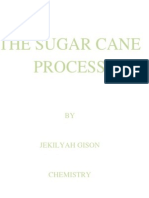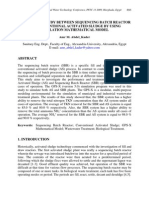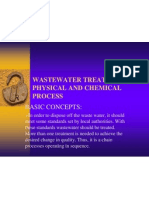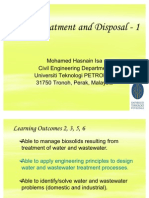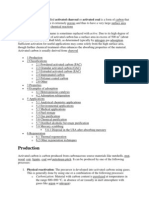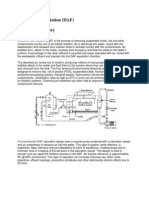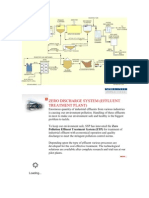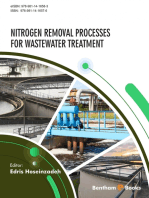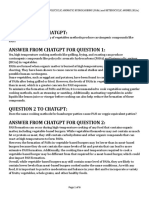0 ratings0% found this document useful (0 votes)
274 viewsActivated Carbon Filtration
Activated Carbon Filtration
Uploaded by
IrhamGranular activated carbon is commonly used to remove organic constituents and residual disinfectants from water supplies. Activated carbon works through adsorption and catalytic reduction, removing organics and disinfectants respectively. The performance of activated carbon depends on factors like molecular weight, pH, contaminant concentration, particle size, flow rate, and temperature. Activated carbon is effective at removing a wide range of organics found in source water and is considered a reliable water treatment method.
Copyright:
Attribution Non-Commercial (BY-NC)
Available Formats
Download as PDF, TXT or read online from Scribd
Activated Carbon Filtration
Activated Carbon Filtration
Uploaded by
Irham0 ratings0% found this document useful (0 votes)
274 views0 pagesGranular activated carbon is commonly used to remove organic constituents and residual disinfectants from water supplies. Activated carbon works through adsorption and catalytic reduction, removing organics and disinfectants respectively. The performance of activated carbon depends on factors like molecular weight, pH, contaminant concentration, particle size, flow rate, and temperature. Activated carbon is effective at removing a wide range of organics found in source water and is considered a reliable water treatment method.
Original Description:
About activated carbon
Copyright
© Attribution Non-Commercial (BY-NC)
Available Formats
PDF, TXT or read online from Scribd
Share this document
Did you find this document useful?
Is this content inappropriate?
Granular activated carbon is commonly used to remove organic constituents and residual disinfectants from water supplies. Activated carbon works through adsorption and catalytic reduction, removing organics and disinfectants respectively. The performance of activated carbon depends on factors like molecular weight, pH, contaminant concentration, particle size, flow rate, and temperature. Activated carbon is effective at removing a wide range of organics found in source water and is considered a reliable water treatment method.
Copyright:
Attribution Non-Commercial (BY-NC)
Available Formats
Download as PDF, TXT or read online from Scribd
Download as pdf or txt
0 ratings0% found this document useful (0 votes)
274 views0 pagesActivated Carbon Filtration
Activated Carbon Filtration
Uploaded by
IrhamGranular activated carbon is commonly used to remove organic constituents and residual disinfectants from water supplies. Activated carbon works through adsorption and catalytic reduction, removing organics and disinfectants respectively. The performance of activated carbon depends on factors like molecular weight, pH, contaminant concentration, particle size, flow rate, and temperature. Activated carbon is effective at removing a wide range of organics found in source water and is considered a reliable water treatment method.
Copyright:
Attribution Non-Commercial (BY-NC)
Available Formats
Download as PDF, TXT or read online from Scribd
Download as pdf or txt
You are on page 1of 0
ACTIVATED CARBON FILTRATION
By Frank DeSilva. Published in Water Quality Products Magazine, January, 2000
Granular activated carbon (GAC) is commonly
used for removing organic constituents and
residual disinfectants in water supplies. This
not only improves taste and minimizes health
hazards; it protects other water treatment units
such as reverse osmosis membranes and ion
exchange resins from possible damage due to
oxidation or organic fouling. Activated carbon
is a favored water treatment technique because
of its multifunctional nature and the fact that it
adds nothing detrimental to the treated water.
Most activated carbons are made from raw
materials such as nutshells, wood, coal and
petroleum.
Typical surface area for activated carbon is
approximately 1,000 square meters per gram
(m
2
/gm). However, different raw materials
produce different types of activated carbon
varying in hardness, density, pore and particle
sizes, surface areas, extractables, ash and pH.
These differences in properties make certain
carbons preferable over others in different
applications.
The two principal mechanisms by which
activated carbon removes contaminants from
water are adsorption and catalytic reduction.
Organics are removed by adsorption and
residual disinfectants are removed by catalytic
reduction. Factors that affect the performance
of activated carbon are:
Molecular weight:
As the molecular weight increases, the
activated carbon adsorbs more effectively
because the molecules are lea soluble in water.
However, the pore structure of the carbon must
be large enough to allow the molecules to
migrate within. A mixture of high and low
molecular weight molecules should be
designed for the removal of the more difficult
species.
pH:
Most organics are less soluble and more readily
adsorbed at a lower pH. As the pH increases,
removal decreases. A rule of thumb is to
increase the size of the carbon bed by twenty
percent for every pH unit above neutral (7.0).
Contaminant concentration: The higher the
contaminant concentration, the greater the
removal capacity of activated carbon. The
contaminant molecule is more likely to diffuse
into a pore and become adsorbed. As
concentrations increase, however, so do
effluent leakages. The upper limit for
contaminants is a few hundred parts per
million. Higher contaminant concentration may
require more contact time with the activated
carbon. Also, the removal of organics is
enhanced by the presence of hardness in the
water, so whenever possible, place activated
carbon units upstream of the ion removal units.
This is usually the case anyway since activated
carbon is often used upstream of ion exchange
or membranes to remove chlorine.
Particle size:
Activated carbon is commonly available in 8
by 30 mesh (largest), 12 by 40 mesh (most
common), and 20 by 50 mesh (finest). The
finer mesh gives the best contact and better
removal, but at the expense of higher pressure
drop. A rule of thumb here is that the 8 by 30
mesh gives two to three times better removal
than the 12 by 40, and 10 to 20 times better
kinetic removal than the 8 by 30 mesh.
Flow rate:
Generally, the lower the flow rate, the more
time the contaminant will have to diffuse into a
pore and be adsorbed. Adsorption by activated
carbon is almost always improved by a longer
contact time. Again, in general terms, a carbon
bed of 20 by 50 mesh can be run at twice the
flow rate of a bed of 12 by 40 mesh, and a
carbon bed of 12 by 40 mesh can be run at
twice the flow rate of a bed of 8 by 30 mesh.
Whenever considering higher flow rates with
finer mesh carbons, watch for an increased
pressure drop!
Temperature:
Higher water temperatures decrease the solution
viscosity and can increase die diffusion rate,
thereby increasing adsorption. Higher
temperatures can also disrupt the adsorptive
bond and slightly decrease adsorption. It
depends on the organic compound being
removed, but generally, lower temperatures
seem to favor adsorption.
Organic Removal
Organic material in public water supplies comes
from decaying plant life, which becomes more
soluble in water over time and exists as large,
high-molecular weight organic acids (non-polar
weak acids). Eventually, smaller molecular
weight acids of varying sizes form. Typical
organic acid molecules range in molecular
weight from a few hundred to tens of
thousands.
The size, number and chemical structure of
organic acid molecules depend on a large
number of factors, including water pH and
temperature. Accordingly, there exists an
almost infinite number of organic acids. As a
result, removing organics can be difficult and is
always site-specific.
Activated carbon's adsorptive properties are
used to remove organics. Generally, adsorption
takes place because all molecules exert forces to
adhere to each other. Activated carbon adsorbs
organic material because the attractive forces
between the carbon surface (non-polar) and the
contaminant (non-polar) are stronger than the
forces keeping the contaminant dissolved in
water (polar).
The adsorptive forces arc weak and cannot
occur unless the organic molecules are close to
the carbon's surface. The large surface am of the
activated carbon, due to its particle size and
pore configuration, allows for the adsorption to
take place.
Factors that decrease solubility and/or increase
accessibility to the pores improve the
performance of the activated carbon filter.
Carbon filter capacity can be roughly estimated
at 0. 1 pound of organics per I pound of carbon
at a flow rate of I to 2 gallons per minute per
cubic foot (gpm/cu.ft.) and a bed depth of 3
feet.
Residual disinfectants removal
Activated carbon can remove and destroy
residual disinfectants (chlorine and chloramine)
through a catalytic reduction reaction. This is a
chemical reaction that involves a transfer of
electrons from the activated carbon surface to
the residual disinfectant. In other words,
activated carbon acts as a reducing agent.
Activated carbon's removal of chlorine reduces
the chlorine to a non-oxidative chloride ion.
The reaction is very fast and takes place in the
first few inches of a new activated carbon bed.
(Where removal of organics by activated carbon
takes minutes, removal of chlorine literally
takes seconds). The chlorine capacity of new
activated carbon is I pound of chlorine per
pound of carbon at a flow rate of 3 to 5
gpm/cu.ft. and a bed depth of 3 feet.
Chloramine removal by activated carbon is a
much slower reaction. The predominant species
of chloramine in city water supplies (pH about
7 to 8) is monochloramine. The reaction with
activated carbon and monochloramine also
renders a non-oxidative chloride ion. Since die
rate of reaction is considerably slower, the flow
rate should be 0.5 gpm/cu.ft. and the bed depth
greater than 3 feet.
Material considerations
Activated carbon beds are filters and need to be
backwashed periodically. A freeboard of about
50 percent should be incorporated into the
vessel design to allow backwash inplace.
Otherwise, external backwash is required. The
backwash step does not "regenerate' the carbon
or de-adsorb contaminants. 'Me backwash step
reclassifies the bed and removes any fines or
suspended matter.
Carbon fines are generated during transport,
handling and loading of activated carbon.
These fines need to be backwashed out before
service. Pre-wetted and backwashed carbons
are available that minimize the fines and also
eliminate the problems mused by carbon dust
in a facility, Loading carbon tanks with dry
carbon is a messy, hazardous job. Using
pre-wetted carbon eliminates the airborne dust
and makes for a clean plant environment.
Processed grades of activated carbon are
available that include medical/pharmaceutical
grades, electroplating grades, and powdered or
pelletized carbons.
Activated carbon is a proven technology for the
removal of naturally occurring organics and
residual disinfectants. Designing an activated
carbon filtration system needs to take into
account the differences in the water to be
treated, the type of activated carbon used, and
the effluent quality and operating parameters.
ADDITIONAL READING:
Cooney, David O., Adsorption Design for
Wastewater Treatment, Lewis Publishers, Boca
Raton, FL (1999)
McGowan, Wes, Residential Water Processing,
Water Quality Association, Lisle, IL (1997)
Meltzer, Theodore H., High Purity Water
Preparation, Tall Oaks Publishing, Littleton, CO
(1993)
Typical Properties of Granulated Activated Carbon
Bituminous Sub-
bituminous
Lignite Nut she
Iodine number 1,000 -
1,100
800-900 600 1,000
Molasses number 235 230 300 0
Abrasion number 80-90 75 60 97
Bulk density as
packed LB/CF
26-28 25-26 23 29-30
Volume activity 26,000 25,000 13,800 0
Iodine and molasses numbers measure pore size distributio
Iodine number is a relative measure of pores at sizes of 10 to 2
Angstroms. It is reported in milligrams of elemental iodin
adsorbed per gram of GAC and determines the area available on th
GAC to adsorb low molecular weight organics.
Molasses number measures the degree a GAC removes color from
a stock solution. It measures pores greater than 28 Angstroms.
These are the pores responsible for removing larger molecular
weight organics such as tannins.
Abrasion numbers represent the relative degree of particle size
reduction after tumbling with a harder material. No reduction is
rated 100, complete pulverization is zero.
GAC System Design Parameters
Chlorine Chloramine Organics
Flow rate
(gpm/ft.1)
1-3 0.5 1-2
Minimum bed
depth (ft.)
2-3 6 3-5
Bed life
Almost
indefinite
2 - 6 weeks 1 - 6 months
You might also like
- Epa Water Treatment Manual Filtration 1Document80 pagesEpa Water Treatment Manual Filtration 1alkemeya100% (1)
- Activated Carbon Filter-1 PDFDocument204 pagesActivated Carbon Filter-1 PDFAnty Sintya Ringgani II100% (1)
- Water TreatmentDocument45 pagesWater TreatmentSarim ChNo ratings yet
- Water Treatment FormulasDocument19 pagesWater Treatment FormulasarjmandquestNo ratings yet
- Sugar Cane Process Chemistry ProjectDocument12 pagesSugar Cane Process Chemistry ProjectJekilyah67% (3)
- FM81 R User ManualDocument10 pagesFM81 R User ManualAzraelsrlNo ratings yet
- Activated Carbon FilterDocument9 pagesActivated Carbon Filtersanabilbaig100% (1)
- Granular Activated Carbon and Powdered Activated CarbonDocument6 pagesGranular Activated Carbon and Powdered Activated CarbonAnjali Kothe100% (1)
- Activated Carbon Treatment of Drinking WaterDocument6 pagesActivated Carbon Treatment of Drinking WaterHaimwant DhanieNo ratings yet
- Equipment Design - Aeration TankDocument6 pagesEquipment Design - Aeration TankKENGERALDNo ratings yet
- Project Semester ReportDocument60 pagesProject Semester ReportPrabhjot Singh TinnaNo ratings yet
- Biological Nutrient RemovalDocument23 pagesBiological Nutrient RemovalvijayendraNo ratings yet
- Gomez - Payongayong-Filtration-ESE144 - AutosavedDocument56 pagesGomez - Payongayong-Filtration-ESE144 - AutosavedMaha GomezNo ratings yet
- CE-311 Biological Treatment I - Activated Sludge ProcessDocument40 pagesCE-311 Biological Treatment I - Activated Sludge ProcessShubham Bansal100% (1)
- SBR DesignDocument10 pagesSBR DesignQuốc TuyênNo ratings yet
- Treatment and Disposal Methods For WastewaterDocument110 pagesTreatment and Disposal Methods For WastewaterMinh Dưng LêNo ratings yet
- Wastewater TreatmentDocument49 pagesWastewater TreatmentAshwani Kumar Pati TripathiNo ratings yet
- Ion Exchange Design - Hand Calculation: Brian Windsor (Purolite International LTD)Document43 pagesIon Exchange Design - Hand Calculation: Brian Windsor (Purolite International LTD)Octiva100% (4)
- Inclined Plate ClarifierDocument2 pagesInclined Plate ClarifierKelvin SiewNo ratings yet
- SITE VISIT TO Waste WATER TREATMENT PLANTDocument12 pagesSITE VISIT TO Waste WATER TREATMENT PLANTNajum U Saqib Bhat100% (1)
- Waste Water TreatmentDocument4 pagesWaste Water TreatmentIbrar ZahidNo ratings yet
- 1 Sludge Treatment and Disposal-1Document27 pages1 Sludge Treatment and Disposal-1Liyana RaisNo ratings yet
- What Is Wastewater Treatment?: EnvironmentDocument9 pagesWhat Is Wastewater Treatment?: EnvironmentAli JawwadNo ratings yet
- Production: Activated Carbon, Also Called Activated Charcoal or Activated Coal Is A Form of Carbon ThatDocument13 pagesProduction: Activated Carbon, Also Called Activated Charcoal or Activated Coal Is A Form of Carbon ThatShanmugam RameshNo ratings yet
- Activated Sludge Process Control and Troubleshooting ChartDocument55 pagesActivated Sludge Process Control and Troubleshooting Chartcbqucbqu100% (5)
- Modeling of Activated Sludge With ASM1 Model, Case Study On Wastewater Treatment Plant of South of IsfahanDocument10 pagesModeling of Activated Sludge With ASM1 Model, Case Study On Wastewater Treatment Plant of South of IsfahanAnish GhimireNo ratings yet
- Demineralized Water System Calculation LTCA P-6010 DMS - RaDocument5 pagesDemineralized Water System Calculation LTCA P-6010 DMS - RaOmar Escudero0% (1)
- Biological Treatment of WastewaterDocument15 pagesBiological Treatment of WastewaterAyomideNo ratings yet
- Iron MN RemovalDocument25 pagesIron MN RemovalAkash Mandal100% (1)
- Depth FiltrationDocument6 pagesDepth FiltrationmansoorNo ratings yet
- An Operator's Guide To Water Treatment CoagulantsDocument7 pagesAn Operator's Guide To Water Treatment CoagulantsMitch ColeNo ratings yet
- Coagulation FlocculationDocument12 pagesCoagulation FlocculationVenkatesh Kumar RamanujamNo ratings yet
- Reverse Osmosis State of The Art in IndonesiaDocument16 pagesReverse Osmosis State of The Art in IndonesiachrisNo ratings yet
- DAF Theory 1Document3 pagesDAF Theory 1rvkumar61No ratings yet
- Sand FilterDocument4 pagesSand FilterBASEM NOMAN ALI MOHAMMEDNo ratings yet
- Activated CarbonDocument69 pagesActivated CarbonSaheed Adewale100% (2)
- Handling Dairy Milk House WastewaterDocument31 pagesHandling Dairy Milk House WastewaterAndreea CalcanNo ratings yet
- EE-2 Mini Project ReportDocument7 pagesEE-2 Mini Project Report63GANESH SINGHCIVIL100% (1)
- Effluent Treatment PlantDocument68 pagesEffluent Treatment PlantSegun Olatayo100% (3)
- Industrial Waste Water Treatment Auxiliary System Post Maintenance ChecksDocument11 pagesIndustrial Waste Water Treatment Auxiliary System Post Maintenance ChecksAbeer arifNo ratings yet
- Chemical AdditionsDocument103 pagesChemical AdditionsAlvin Kim100% (2)
- WASTEH20 MBR Process Design PDFDocument23 pagesWASTEH20 MBR Process Design PDFDavid LambertNo ratings yet
- Specification RO Water Treatment PlantDocument16 pagesSpecification RO Water Treatment PlantZachi UkiNo ratings yet
- Biological Nutrient Removal ProcessDocument66 pagesBiological Nutrient Removal ProcessEuseNo ratings yet
- Activated Carbon For Waste Water Treatment v2 NDocument8 pagesActivated Carbon For Waste Water Treatment v2 NMohammed A. Helal100% (1)
- Laundry Wastewater Treatment Using CoaguDocument20 pagesLaundry Wastewater Treatment Using CoaguAnggy de Rincon100% (1)
- Activated Carbon PDFDocument28 pagesActivated Carbon PDFCleverSeyramKetekuNo ratings yet
- Sludge DisposalDocument62 pagesSludge Disposalblumunchie100% (2)
- Overview of Activated Sludge ProcessDocument32 pagesOverview of Activated Sludge ProcesssoorajTVMNo ratings yet
- Journal of Water Process Engineering: SciencedirectDocument11 pagesJournal of Water Process Engineering: SciencedirectAndrés Julián Londoño CadavidNo ratings yet
- Fundamentals of Water Treatment Unit Processes (Feb 2013)Document9 pagesFundamentals of Water Treatment Unit Processes (Feb 2013)lalo2385100% (1)
- Case Study - Wastewater ETPDocument21 pagesCase Study - Wastewater ETPsarwar jahanNo ratings yet
- MBBR TechnologyDocument5 pagesMBBR Technologymsajidfcc100% (2)
- Process Wastewater CharacteristicsDocument12 pagesProcess Wastewater CharacteristicsYeAsin AraFatNo ratings yet
- FINALDESIGNPROJECTDocument134 pagesFINALDESIGNPROJECTVineet ChaudharyNo ratings yet
- Systematic Methods of Water Quality Parameters Analysis: Analytical MethodsFrom EverandSystematic Methods of Water Quality Parameters Analysis: Analytical MethodsRating: 1 out of 5 stars1/5 (1)
- Water Treatment Plant Performance Evaluations and OperationsFrom EverandWater Treatment Plant Performance Evaluations and OperationsNo ratings yet
- 42 327 1 PB PDFDocument9 pages42 327 1 PB PDFIrhamNo ratings yet
- PIN March10 WebDocument37 pagesPIN March10 WebIrhamNo ratings yet
- International Conference On "Corporate Governance Reform: China and East Asia"Document40 pagesInternational Conference On "Corporate Governance Reform: China and East Asia"IrhamNo ratings yet
- Technical Challenges & Design Features LNG TankDocument8 pagesTechnical Challenges & Design Features LNG TankIrhamNo ratings yet
- Introduction To The Management and Regulation of The Norwegian Seaweed Industry P ('t':3) Var B Location Settimeout (Function (If (Typeof Window - Iframe 'Undefined') (B.href B.href ) ), 15000)Document2 pagesIntroduction To The Management and Regulation of The Norwegian Seaweed Industry P ('t':3) Var B Location Settimeout (Function (If (Typeof Window - Iframe 'Undefined') (B.href B.href ) ), 15000)IrhamNo ratings yet
- Case Study - Global Leadership Agility AssessmentDocument1 pageCase Study - Global Leadership Agility AssessmentIrhamNo ratings yet
- Maintenance Manual IoclDocument29 pagesMaintenance Manual IoclSharique Aman100% (2)
- Stabilized Rice Bran and The Arsenic MythDocument2 pagesStabilized Rice Bran and The Arsenic MythGapperNo ratings yet
- 30 01 2023 Chemistry - Paper+With+Answer - MorningDocument7 pages30 01 2023 Chemistry - Paper+With+Answer - MorningLana100% (1)
- Balancing Redox Reactions in General Chemistry 2Document2 pagesBalancing Redox Reactions in General Chemistry 2STEM11B Manlapaz Jose Gabriel P.No ratings yet
- Fresnido Final PaperDocument54 pagesFresnido Final Paperenojosa nhoelNo ratings yet
- IUPAC - Practice Sheet - IUPAC Nomenclature - ManzilDocument9 pagesIUPAC - Practice Sheet - IUPAC Nomenclature - ManzilShio100% (1)
- Fuel Specification Guide: Shell Marine ProductsDocument6 pagesFuel Specification Guide: Shell Marine ProductsVilius BukysNo ratings yet
- Chemical Free Bar SoapDocument3 pagesChemical Free Bar SoapgloirszidaNo ratings yet
- Bioremediation of Red Mud by Fungi Aspergillus PDFDocument9 pagesBioremediation of Red Mud by Fungi Aspergillus PDFeldin johnsonNo ratings yet
- Polycyclic Aromatic Hydrocarbons (PAHs) and Heterocyclic Amines (HCAs)Document6 pagesPolycyclic Aromatic Hydrocarbons (PAHs) and Heterocyclic Amines (HCAs)shawnleegabrielNo ratings yet
- C2H2 Molecular Geometry and Bond AnglesDocument3 pagesC2H2 Molecular Geometry and Bond AnglessssNo ratings yet
- Fenestration in BuildingsDocument38 pagesFenestration in Buildingsrohit14oct100% (1)
- 10th Science Byjus SolutionsDocument159 pages10th Science Byjus SolutionsChinmay B PNo ratings yet
- Pressure Vessel - Columns - AnimateDocument16 pagesPressure Vessel - Columns - AnimateSamir ChaudharyNo ratings yet
- Membrane Structure and Function POGILDocument8 pagesMembrane Structure and Function POGILzrahman7671No ratings yet
- Teal Sheets Addendum 02 - 2008Document2 pagesTeal Sheets Addendum 02 - 2008joséNo ratings yet
- 1 s2.0 S2590171022000078 MainDocument12 pages1 s2.0 S2590171022000078 MainMarcos Hugo SalazarNo ratings yet
- Vent Sizing For Fire Considerations For External Fire Duration Diers Users Group Ers Design For Fire CommitteeDocument19 pagesVent Sizing For Fire Considerations For External Fire Duration Diers Users Group Ers Design For Fire CommitteekglorstadNo ratings yet
- Stock 6 Juni 2023Document42 pagesStock 6 Juni 2023Faishal Adi CandraNo ratings yet
- 10 1021@acsreagents 2008Document3 pages10 1021@acsreagents 2008Quercus AlbaNo ratings yet
- Dermatite Final ThesisDocument60 pagesDermatite Final ThesisAzeze AshenefeNo ratings yet
- Class Test-2 Chemistry: Vidyamandir ClassesDocument1 pageClass Test-2 Chemistry: Vidyamandir Classesbrainx MagicNo ratings yet
- Characterization and Surface Treatment Effects On Topography of A Glass-Infiltrated Alumina:zirconia-Reinforced CeramicDocument7 pagesCharacterization and Surface Treatment Effects On Topography of A Glass-Infiltrated Alumina:zirconia-Reinforced CeramicNaoki MezarinaNo ratings yet
- Biomass Fired BoilersDocument12 pagesBiomass Fired Boilersnathabbu100% (2)
- SupportsDocument141 pagesSupportsdpdcp100% (1)
- Iso 11126 7 2018Document9 pagesIso 11126 7 2018Ludwig Datuk JiangNo ratings yet
- Ducted Blower Split Systems: ModelsDocument171 pagesDucted Blower Split Systems: ModelsRicardo Molina SánchezNo ratings yet
- Working and MachiningDocument16 pagesWorking and MachiningAdel AbduoNo ratings yet




